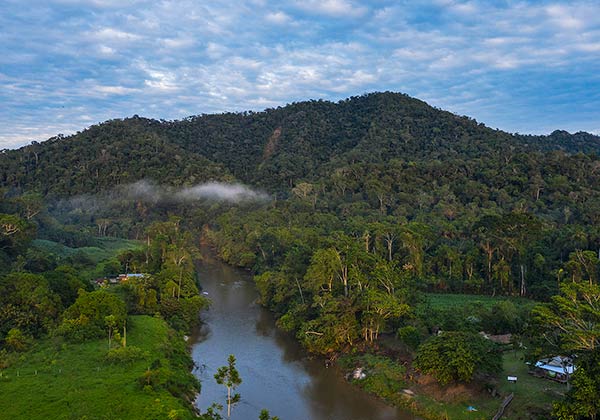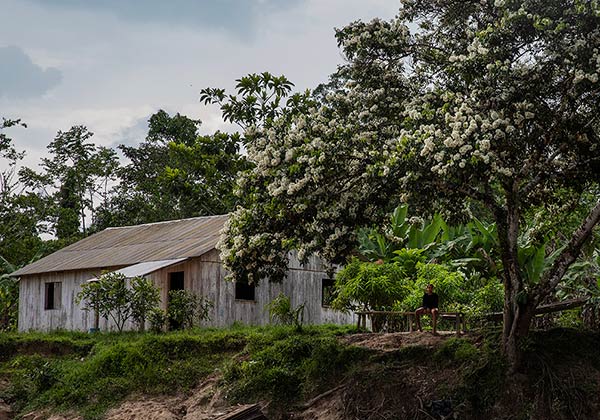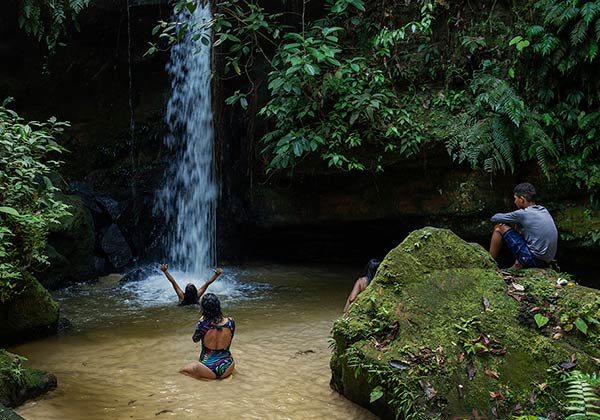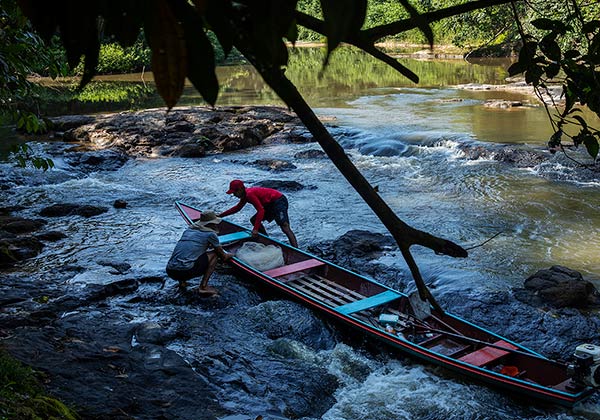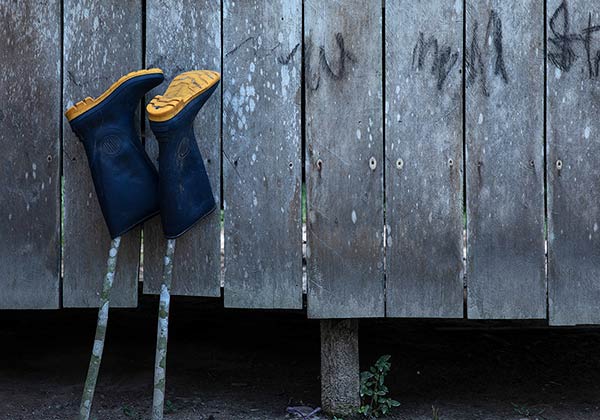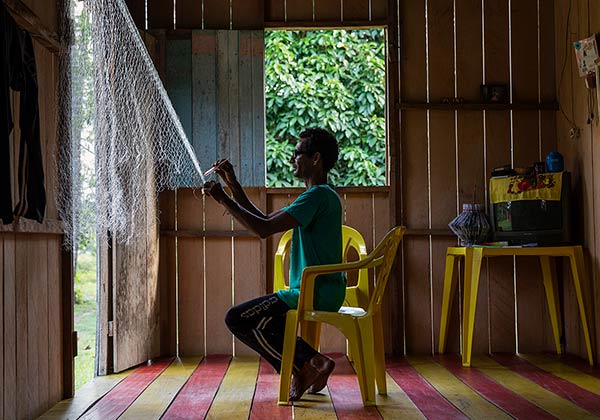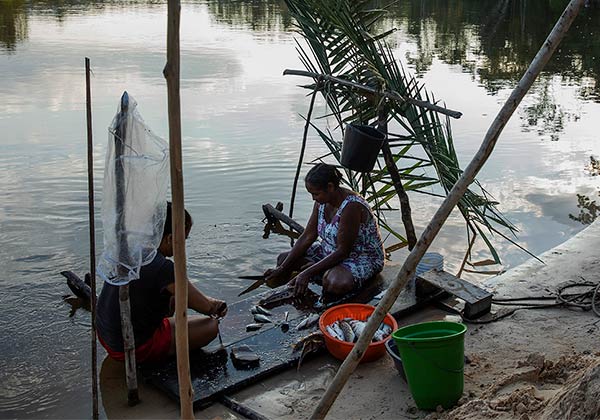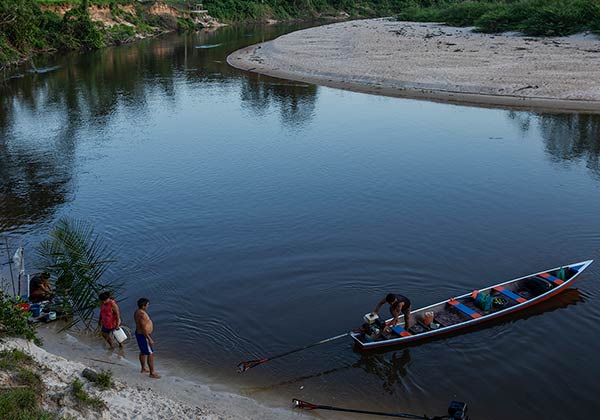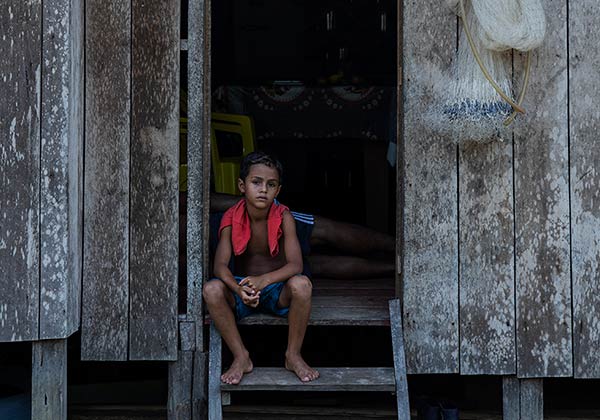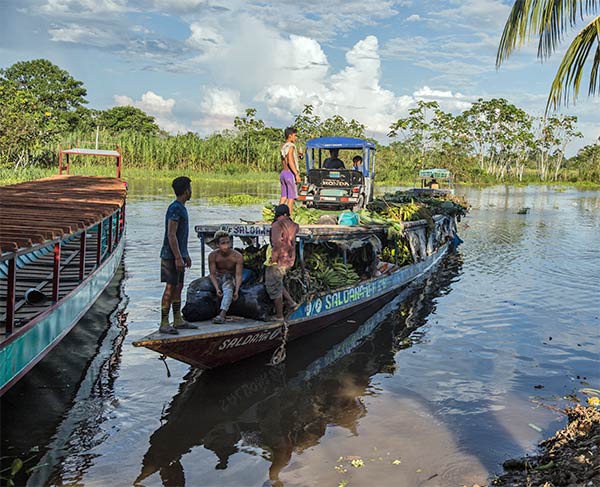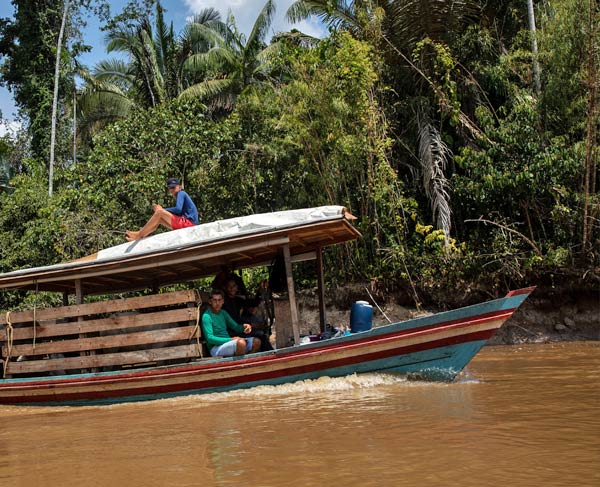Brazil
Mâncio Lima. Aerial view of the Moa river in the Serra do Divisor National Park, in Acre.
Photo: Lalo de Almeida / Folhapress
Serra do Divisor National Park
Threatened by a new highway
By: Fabiano Maisonnave
Photos: Lalo De Almeida
On Planet Earth, the choca-do-acre has been found only on one summit, inside the Serra do Divisor National Park. The habitat of this dark-plumaged, surly bird is limited to shrubby woodlands, one of the ten types of forests in this protected area on the border of Brazil and Peru.
Home to numerous endemic animals and to at least 1,163 plant species, the Serra do Divisor is one of the most biodiverse regions in the world. Despite this, two parallel projects plan the construction of a highway dividing the national park in two and allowing for the privatization of the park’s territory, opening the way for deforestation, cattle and mineral extraction.
The proposals are promoted by two pro-Bolsonaro congressmen from the state of Acre. The idea of the highway was adopted by the government of Jair Bolsonaro, which has already taken the first steps toward the construction of the Brazilian side of the highway, but has not yet made public its position on a bill pending in Congress that puts an end to the Serra do Divisor National Park.
The extension of BR-364, as the highway is known, which currently ends in Mâncio Lima, a small town 415 miles from Rio Branco and next to Cruzeiro do Sul, was first discussed in the 1970s during the military dictatorship and was foreseen in the decree for the creation of the Serra do Divisor National Park in 1989, during the government of then-President José Sarney. But the project seemed to have been forgotten with the inauguration in 2010 of the Interoceanic Highway (Pacific Highway) linking Acre and Brazil to the Peruvian coast.
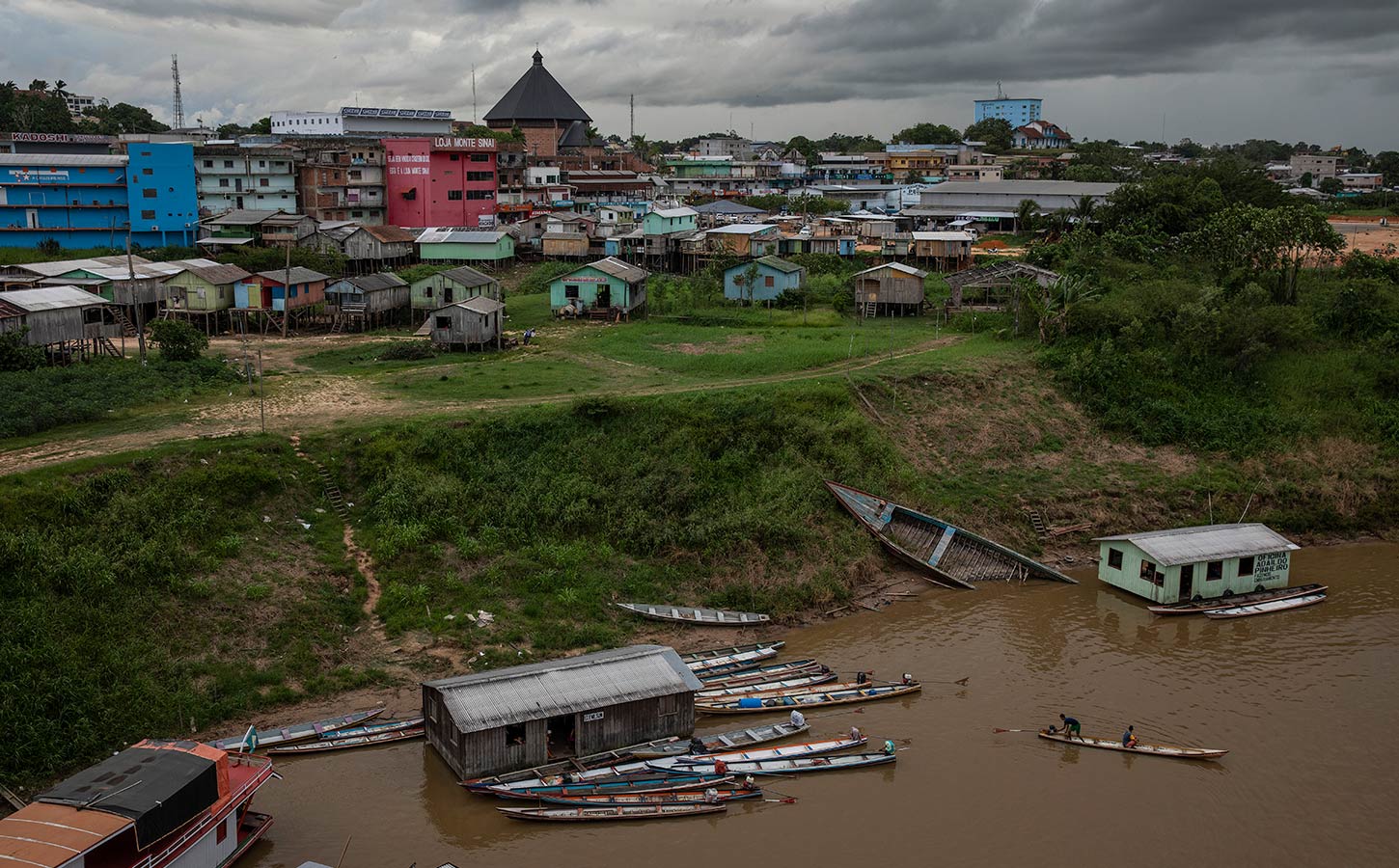
Cruzeiro do Sul, AC. 01/11/2020. Houseboats on the Juruá River in the city of Cruzeiro do Sul, Acre.
Photo: Lalo de Almeida / Folhapress
Then Bolsonaro’s term began. In 2020, three of his ministers were in Acre to address the issue. In June, Ricardo Salles (Environment) visited the area where the construction would begin. In September, Ernesto Araújo (Foreign Affairs) and Rogério Marinho (Regional Development) visited Cruzeiro do Sul, the largest city in the Juruá Valley region, where the road would cross. They met with local and Peruvian politicians.
Also in September, Bolsonaro himself defended the project in a Facebook live address, affirming that he will open a road from Brazil to the Pacific, echoing the speech of former President Lula da Silva in the 2000s, when he made the first highway viable, in partnership with his Peruvian colleague Alejandro Toledo, now a fugitive from justice.
The National Transport Infrastructure Department (DNIT) says it will publish in June the call for bids on the project budgeted at about $93 million, according to official estimates. The bureau said there is still no detailed mapping of the federal highway, but that the Brazilian side will be about 75 miles long, of which almost 13 miles (17%) will be inside the Serra do Divisor National Park.
In the region, the project divides opinions
Indigenous and river community leaders say that so far, they have not been consulted about the highway, as required by law, and foresee negative socio-environmental impacts. "As of today, you were the first person to ask me about the highway," cacique Joel Puyanawa told Stories Without Borders in a conversation at his village's cultural center.
Separated from the urban center of Mâncio Lima by a six-mile dirt road, the Terra Indígena Poyanawa, with approximately 680 inhabitants, is in the area of direct influence of the highway. Salles was there on June 27, but Puyanawa did not meet with him. The Environment Minister defended the road project when he met with indigenous leaders, saying, "it is time for integration.”
Mâncio Lima, AC. 05/11/2020. Boats settled on the banks of the Japiim River in Mâncio Lima, Acre, near the Serra do Divisor National Park.
Photo: Lalo de Almeida / Folhapress
"The entire surroundings of our land are already compromised. We already know the damage caused by the invasions. The whites live by hunting on our land and the environmental institutions have no policy to prevent it. Imagine a highway. How many millions of people are going to travel along it? Will agribusiness increase? Yes, but our survival is not in agribusiness,” says Puyanawa, who was recently elected to the municipal government.
Puyanawa also fears that the road will pass over a sacred zone, located outside the demarcated indigenous land. It was in this region that, around 1910, its people were captured for slavery by the rubber-tapper colonel Mâncio Lima (1875-1950). Despite this, Mâncio Lima is portrayed as a hero in official history, to the extent of being honored with the name of the city.
"This road threatens 100% of our land, it destroys our sacred site. The damage done by the colonel was enough. If the road is built, it exterminates the history of our people," Puyanawa says.
On the other hand, mayors and businessmen are betting on the highway to put an end to the geographic isolation of the westernmost region of the country. The re-elected mayor of Mâncio Lima, Isaac Lima (he is not related to the colonel), is an enthusiast of the highway, to the point of opening, on his own, some 25 miles of path along the probable route of the highway.
For the cattle rancher, the connection with Pucallpa, 460 miles away from the Lima highway, would bring benefits to the city of 19,000 inhabitants, which lives mainly from cattle raising and family farming. "The highway would connect the whole world and bring to our region, surely, development, growth, and Mâncio Lima would be the gateway," Isaac Lima says.
The person who is largely responsible for the resumption of the idea is far right-wing Senator Márcio Bittar. A staunch ally of Bolsonaro, as he defines himself, Bittar holds the strategic position of rapporteur of the 2021 Budget, which gives him the power to direct funds to the highway, among other functions.
In parallel, Bolsonarista federal deputy Mara Rocha presented in November 2019 the legislative bill (PL) 6.024, which would transform the national park into a paradoxically named Environmental Protection Area (EPA). The change would open the way for land privatization, deforestation, timber extraction, cattle raising, mining and shale gas exploitation.
Mâncio Lima, AC. 11/05/2020. Boat transporting cattle on the Moa River, inside the Serra do Divisor National Park in Acre.
Photo: Lalo de Almeida / Folhapress
More skeptical, the governor of Acre, right-wing Gladson Cameli, was not present at any of the ministerial visits to discuss the road. In a phone interview, he said that the project is "medium to long term" and that the state has other priorities, such as increasing the trade through the first interoceanic highway.
Cameli says he is against downgrading the park to an EPA and that his main concern about the highway is the possible increase in Peruvian cocaine smuggling in the Cruzeiro do Sul region, the main entry route to Acre. “[The gangs] are dominating. Borders need a greater presence of the rule of law.”
In reaction to the way the highway is being planned by the federal government and parliamentarians, the Federal Public Prosecutor's Office initiated an investigation into irregularities in the managing of the project.
According to the Attorney General Lucas Costa Almeida Dias, the objective is to ensure that "indigenous communities are consulted in a prior, free and informed manner", in accordance with Convention 169 of the International Labor Organization, to which Brazil is a signatory.
Dias said the route of the highway should consider the possible presence of isolated indigenous communities and that the licensing should be done by the federal environmental bureau, with the participation of Brazil’s indigenous bureau, and not by the state environmental agency, which is susceptible to political pressures.
Coastal and indigenous people
Stories Without Borders visited the northern region of the Serra do Divisor National Park in late October and early November, taking a 9-hour boat trip on the Moa River from Mâncio Lima to the Pé da Serra community, the westernmost town in Brazil.
With three inns maintained by local residents, it is the base for tourists in search of waterfalls, panoramic views and jungle trails. One of the most beautiful and impressive sites is the Moa River canyon. It is a 40-minute boat ride amidst green mountains, a scenery more often associated with the Peruvian Amazon, close to the Andes.
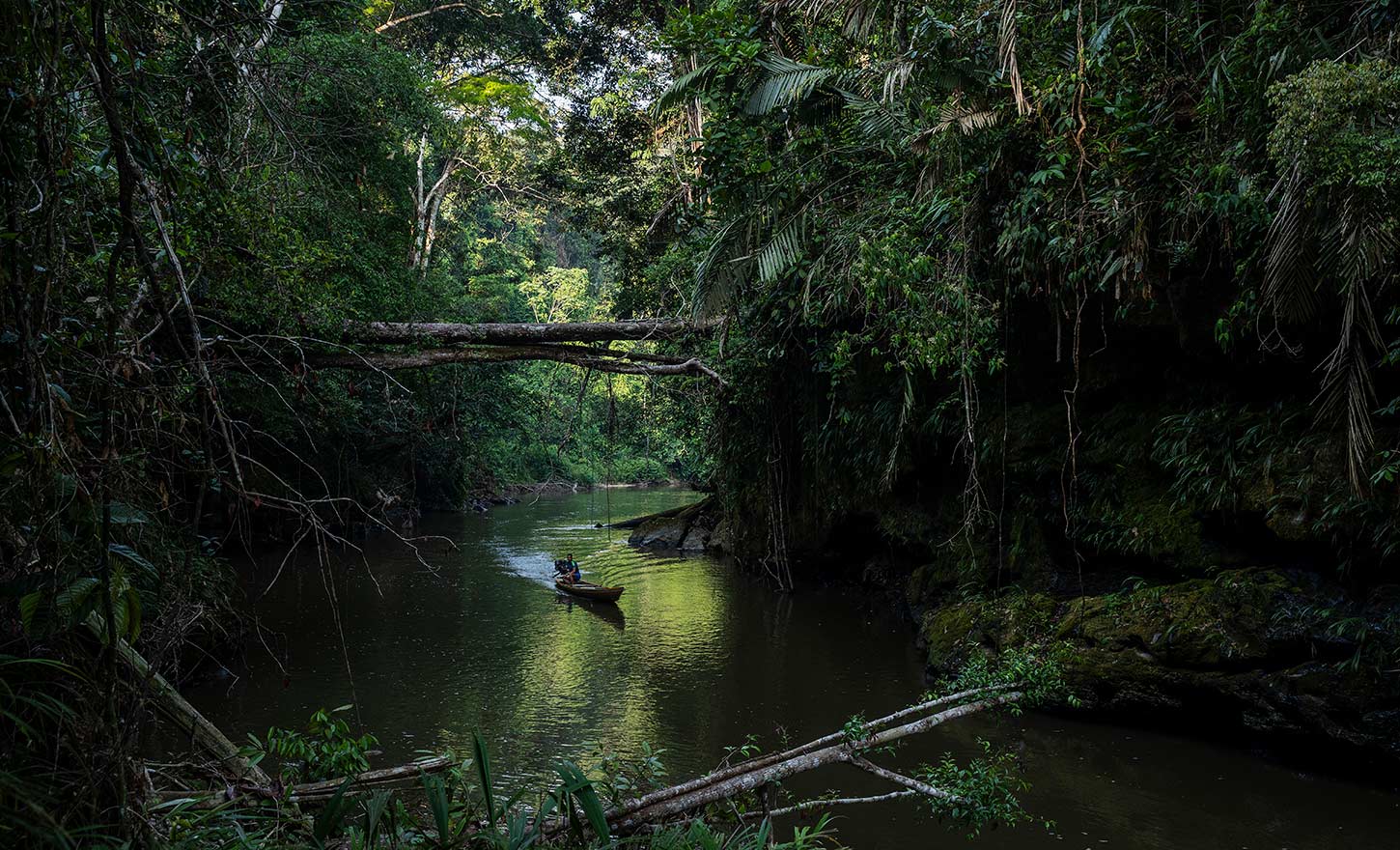
Mâncio Lima, AC. 05/11/2020. A canoe navigates the waters of the Moa River in the Serra do Divisor National Park, in Acre, one of the most biodiverse areas of the Amazon.
Photo: Lalo de Almeida / Folhapress
Despite being prohibited by law, about 350 coastal families live inside the park, along the Moa and Juruá-Mirim rivers. Most of them were already living there when the park was created, but, three decades later, the federal government has never concluded the resettlement of these families. In Pé da Serra, they live off tourism, non-mechanized agriculture, hunting and fishing.
Electricity comes from generators and solar panels. The houses distributed along the banks are close to the first mountain range, which at dawn is covered by fog. Transportation is carried out in canoes with small motors piloted by adults and children. Without Internet, a single public telephone allows communication with the world.
Born and raised on the banks of the Moa River, 41-year-old farmer Eva Maria Lima da Silva says she opposes both the park's extinction and the opening of the highway. A cook at the pioneering Pousada do Miro, she says that the park prevented the expansion of cattle and that tourism is the best economic alternative.
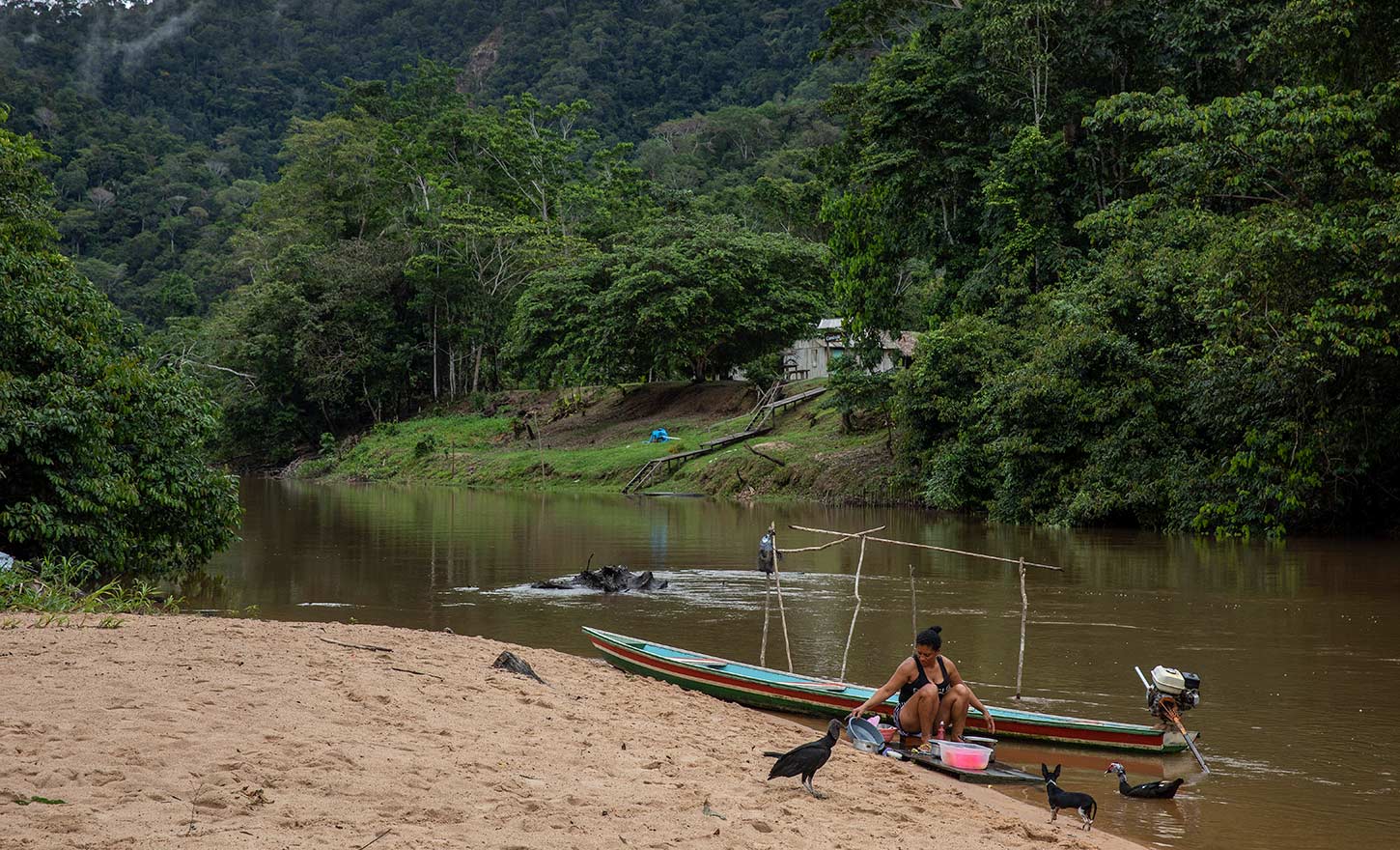
Mâncio Lima, AC. 03/10/2020. Farmer Eva Maria Lima, inhabitant of the Pé da Serra community, inside the Serra do Divisor National Park, washes pots in the Moa River.
Photo: Lalo de Almeida / Folhapress
"If the highway is built, our park will be affected. It would be good because of the speed, but, traveling along the river, our road, how many beauties do I not see? How many jungles are not preserved?" she said.
Another long-time resident, 51-year-old farmer and artisan João Silva, says the road would be beneficial in reducing the community's isolation: "Suddenly, if we need to go to the street, we would take the road, it's faster.”
On the other hand, he disagrees with the proposal to extinguish the park -- a project that residents were unaware of until they were questioned by this report. "In a sense, I thought it was good, because a guy could find a job. But leaving it untapped would be better. We stay quiet, no one is going to mess with us. If these people come in, they're going to take a lot of people out of here. Farmers are going to come in, buy, and a lot of them are going to have to leave," Silva says.
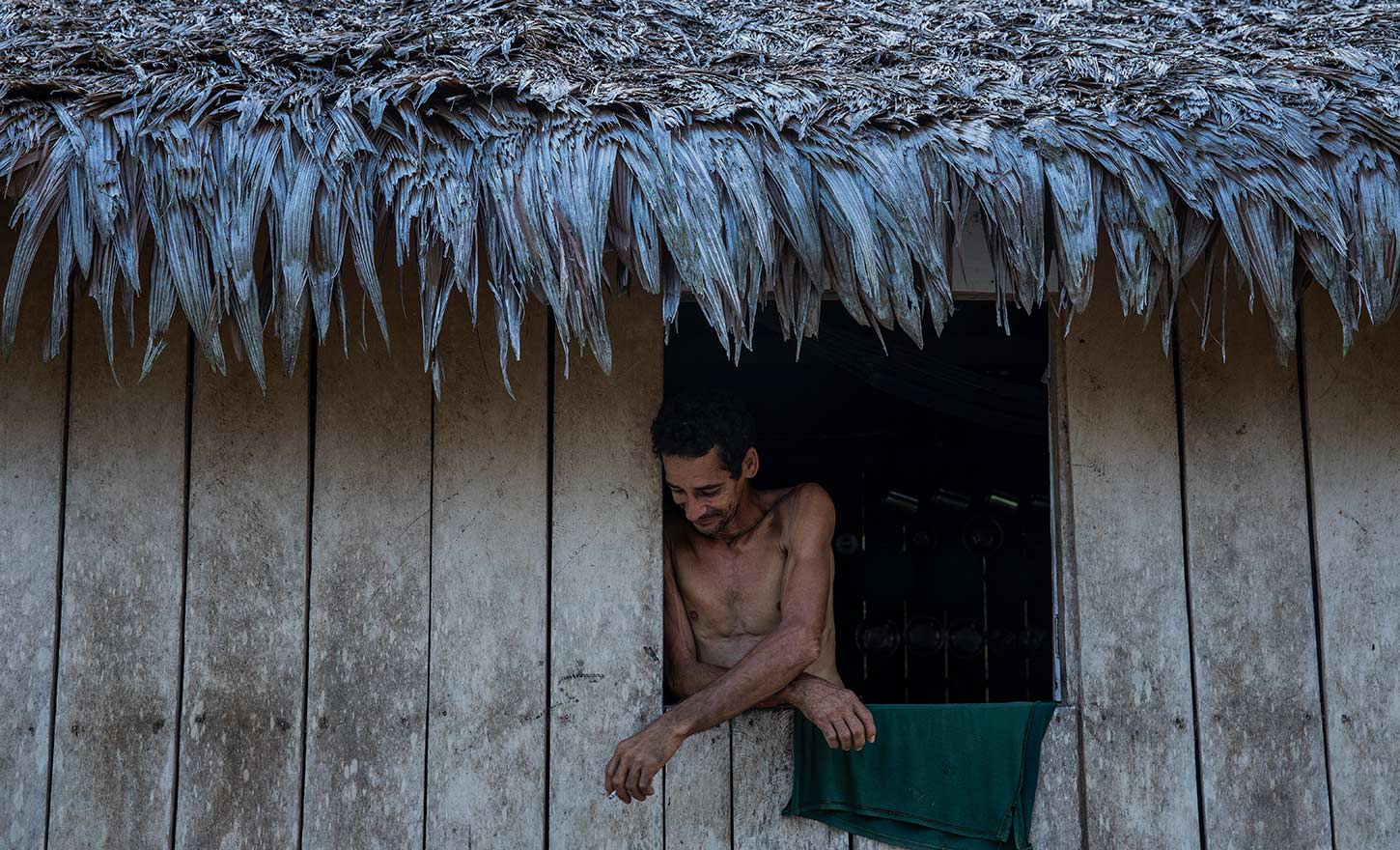
Mâncio Lima, AC. 05/11/2020. Riverside resident João Silva dos Santos at the window of his house in the Pé da Serra community, in the Serra do Divisor National Park.
Neighbors of the park and historical inhabitants of the Moa River and Serra do Divisor, the Nukini natives reject both the highway plan and the transformation of the project into an EPA, according to cacique Paulo Nukini, 39. He was not consulted about the project. His people demand that part of the park be annexed to the indigenous territory, which was approved in 1991.
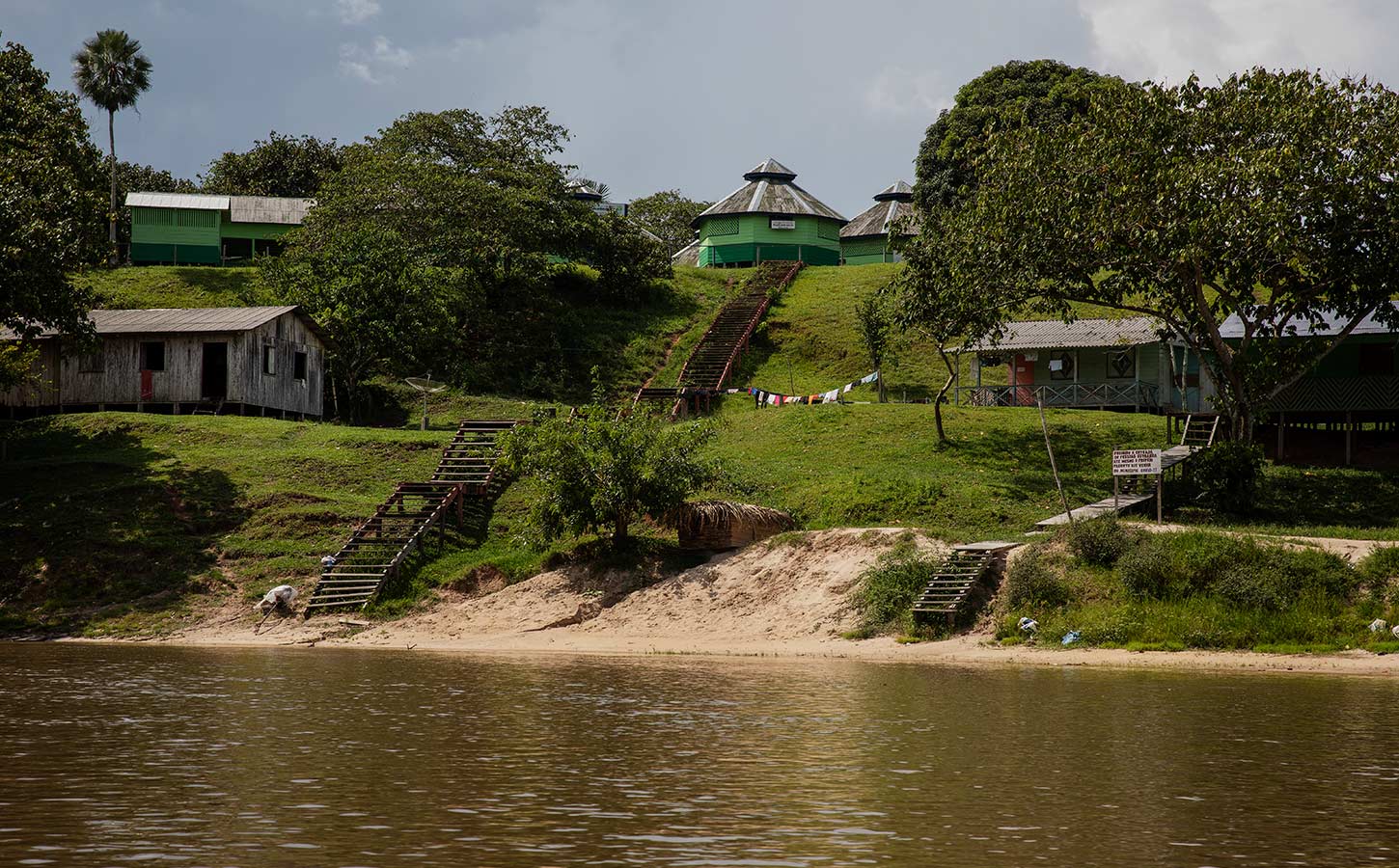
Mâncio Lima, AC. 30/10/2020. Nukini village on the banks of the Moa River, near the Serra do Divisor National Park, in Acre.
"We are against it because we know it is going to cause a strong impact, a lot of deforestation. It can increase access to contraband [cocaine trafficking]. And it will leave our sierra with a high risk of contamination. For us, Nukinis, the sierra is a sacred place," says the leader, speaking in front of his village on the river bank. "Brazil has lived until today without needing that passage there."
Researcher's paradise
The rich biodiversity and large number of endemic species in the Serra do Divisor is due mainly to the varied altitude, between 650 and 2,100 feet. In addition, it has three types of rivers that exist in the Amazon: white water (muddy), black water (color of black tea) and clear water (transparent). Finally, it is the only integral protection zone in Brazil that contains a branch of the Andes Mountains, including part of its flora and fauna.
"Since 1901, about 3,500 botanical collections have been made in the Serra do Divisor, with the record of 1,163 species," says Federal University of Acre (Ufac) biologist Marcos Silveira, who has been researching the area for 24 years. "The number of vascular plant species [with sap-conducting vessels] represents 8.3% of the known diversity in the Amazon."
Mâncio Lima, AC. 05/11/2020. Aerial view of the forest in the Serra do Divisor National Park, in Acre.
Photo: Lalo de Almeida / Folhapress
The catalog continues to grow. Along with other researchers, the biologist is preparing an article which shows that the list of species registered in the park has increased 63% since 1997, when 720 plants were identified. On average, three species are found in Serra do Divisor every two months, that is, they are new species for the conservation unit, unknown in Acre and even new to science.
Fauna is not far behind. "When we do inventories, we always have a great opportunity to collect new species. It's impressive," says Ufac biologist Elder Morato.
Two species of bees discovered in the Divisor were named in his honor: Euglossa moratoi, one of about 30 species of orchid bees found in the park, and Dolichotrigona moratoi, one of about 60 native stingless honey bees.
Another stingless bee discovered in the park is the Celetrigona euclydiana, a tribute to Brazilian writer Euclides da Cunha, who, at the beginning of the 20th century, was in Acre to direct the border delimitation works between Brazil and Peru.
"For us biologists, the Serra do Divisor is emblematic. It is no exaggeration to say that everyone dreams of visiting it someday," says a commentary signed by researchers Leandro Moraes (University of São Paulo), Tomaz Melo (Federal University of Amazonas) and Raíssa Rainha. All of the researchers are also linked to the National Institute of Amazon Research, based in Manaus.
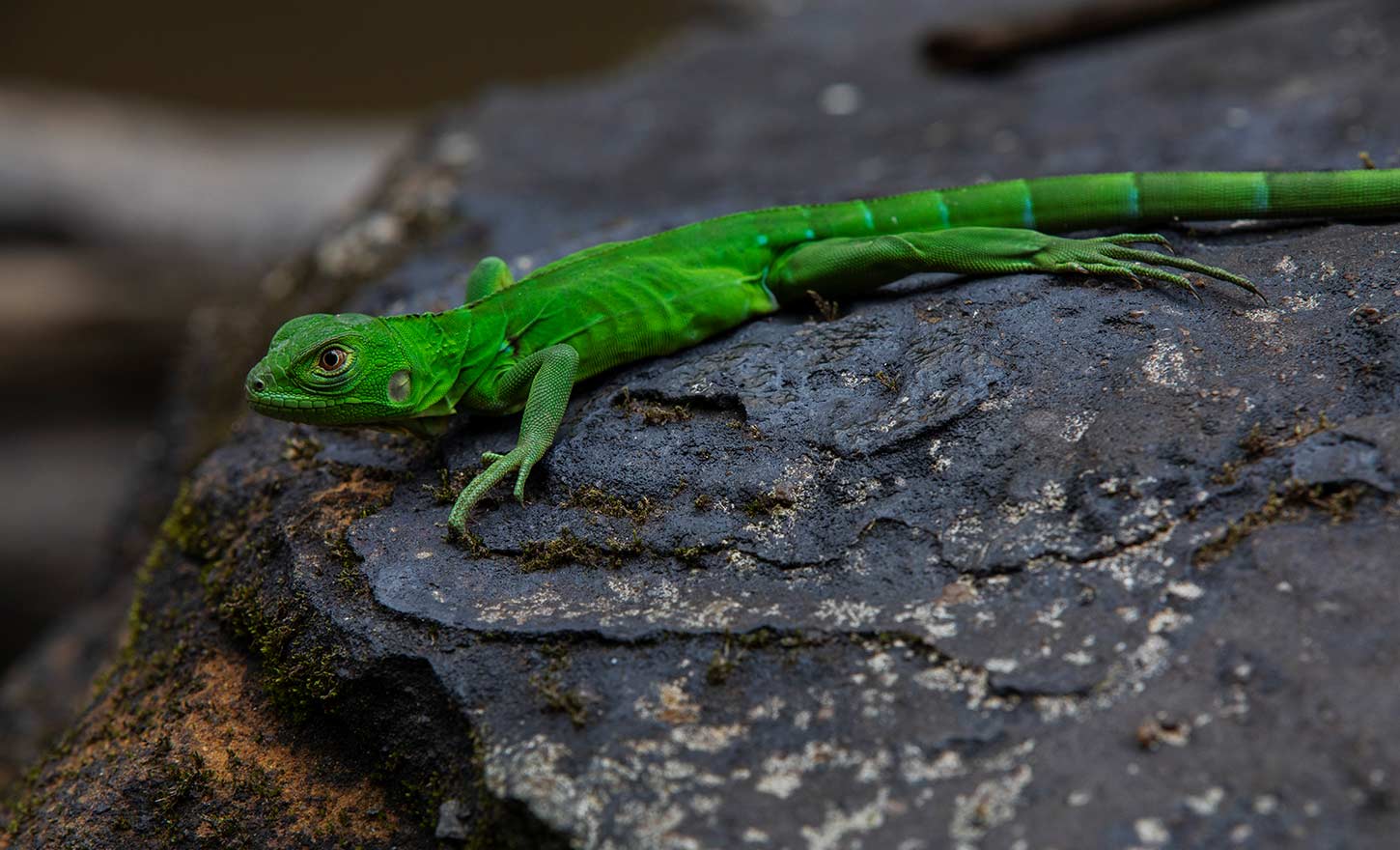
Mâncio Lima, AC. 05/11/2020. Lizard rests on a rock on the banks of the Moa River in the Serra do Divisor National Park, in Acre.
Photo: Lalo de Almeida/ Folhapress
In November 2019, the three biologists participated in a research expedition for a vertebrate census to commemorate the park's 30th anniversary. They found nearly 80 species of amphibians and 40 species of lizards and snakes.
In addition, 326 bird species were identified, of which at least 5 are new records for the park, which now has more than 500 catalogued bird species. One of them has become the symbol of the region: the choca-do-acre (Thamnophilus divisorius). A resident of the highest areas, Serra do Divisor is the only place on the planet where the choca-do-acre can be found.
"This wide-ranging diversity is only documented in other regions of the Amazon after decades of studies in the same place. In Serra do Divisor, we recorded it in less than 15 days of sampling. Many of these species are quite restricted to this region and are no longer found in the eastern direction of Acre," the researchers say.
Such diversity led the Ministry of Environment to file an application in 2017 to establish the Serra do Divisor National Park as an UNESCO Natural World Heritage Site. This distinction has only been granted to two other Amazon regions: the Manú National Park, in Peru, and the Central Amazon, a set of four conservation units in the State of Amazonas (Jaú, Anavilhanas, Mamirauá and Amanã).
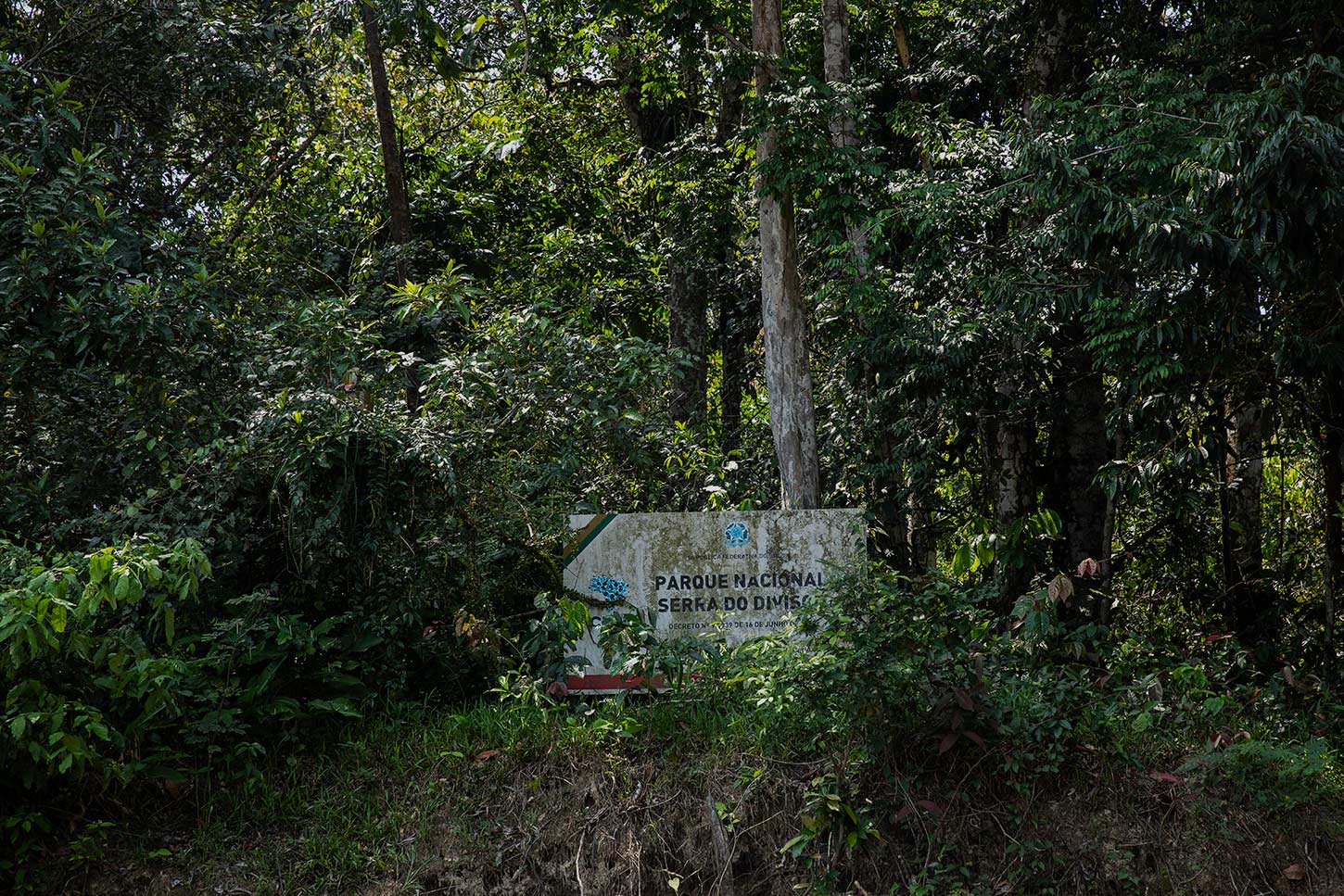
Mâncio Lima, AC. 05/11/2020. Sign indicating the limits of the Serra do Divisor National Park, in Acre.
Photo: Lalo de Almeida/ Folhapress
The proposal, however, ended up being withdrawn days later due to pressure from the National Defense Council, a military-led body. The allegation was that it was a threat to national security.
Quarry in the park
In the legislation that transforms the park into an EPA, Congresswoman Mara Rocha used 213 words to justify the end of the national park. No environmental or economic study is cited to justify the elimination of the only comprehensive Brazilian protected area located within a pre-Andean zone where there is a transition between the Andean fauna and flora and the lower Amazon.
For the congresswoman, the 2-million-acre park (the ninth largest in the country) "meets the interests and needs of the people of Acre" because it is the "only region in the State that has rocks that can be extracted and used in construction to promote the economic development of the State.”
In a video released in January 2020, she states that the goal is for the park to allow human habitation and that the "project is authored by Senator Márcio Bittar."
On the phone, Bittar tried to dissociate himself from his ally's initiative. He said he is not such an "idiot" that he would present legislation to get rid of the park. But defended the legislation’s content. "Germany, which finances NGOs linked to the national media, made an Itaipu (Brazil’s largest hydroelectric dam) and a half in thermoelectric, digging hole in the ground for coal. Now, we, in poor Acre, miserable, in the miserable Amazon, have no stone."
"If inside the reserve there is a stone deposit without a square kilometer, you can't take it out, because the law says you can't take it out. If there is oil there, can you take it out? You can't. And it will continue like that, because I am not an idiot and I know that, if I present such a bill, it will not be approved," he added.
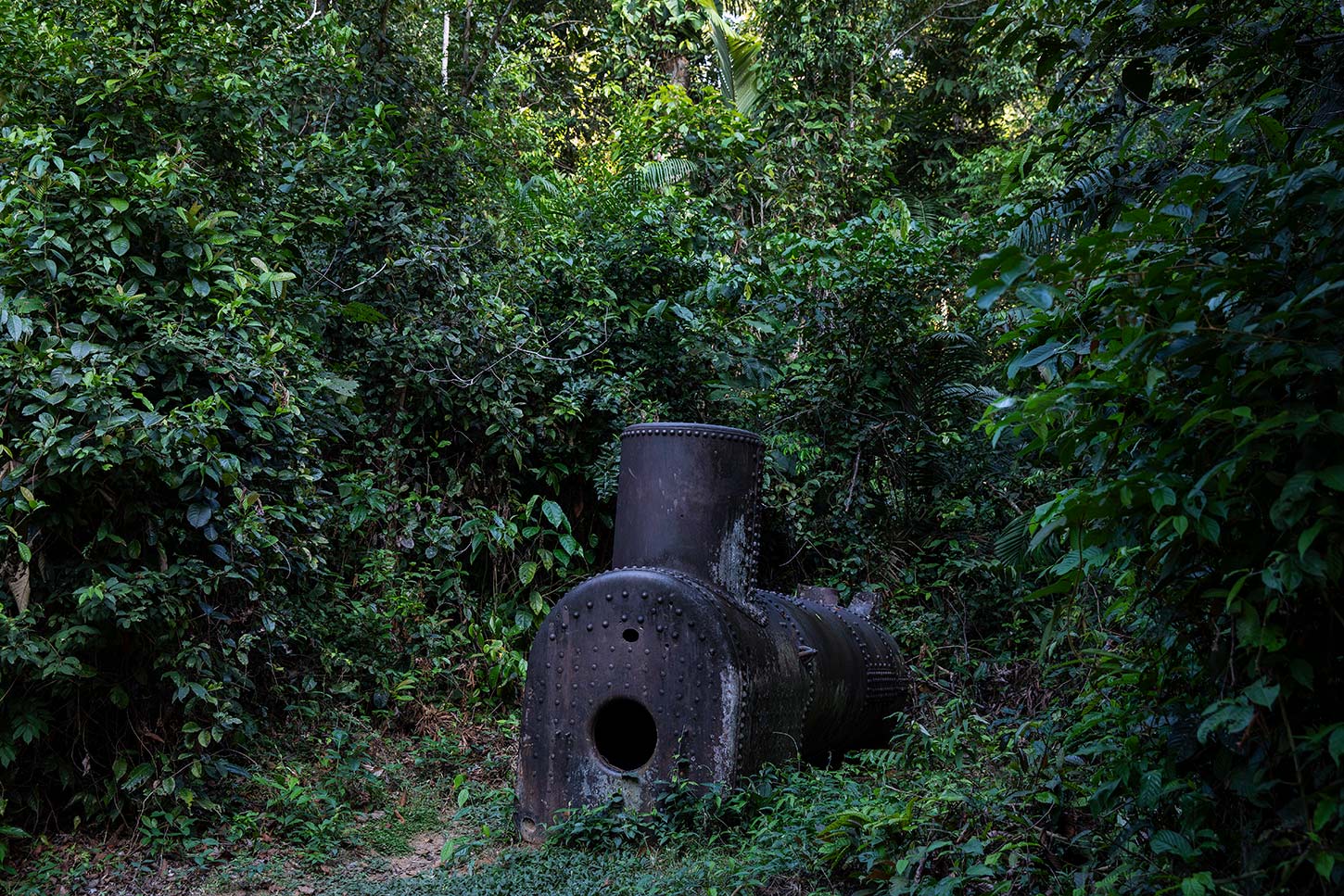
Mâncio Lima, AC. 05/11/2020. Old boiler used in a borehole to probe the ground carried out by Petrobras on the banks of the Moa River inside the Serra do Divisor National Park, in Acre.
Photo: Lalo de Almeida/ Folhapress
The reporter attempted to speak with Rocha, but the federal congresswoman did not respond to the request for an interview.
First binational highway
The fact is that, since 2010, Acre has had a connection with the Peruvian Pacific through Assis Brasil. However, the construction work, executed almost entirely in the neighboring country, did not fulfill the promise of transforming the Amazonian state into an export hub or a corridor to Asia. In Peru, the highway caused an explosion of deforestation and illegal logging and is at the center of the "Peruvian Lava Jato,” a corruption scandal that shook the neighboring country's politics.
The year the work was inaugurated, Acre's exports represented 0.4% of state GDP. In 2018, the latest year for which data is available, this percentage rose to only 0.7%. The data are from the Ministry of Economy and the Brazilian Institute of Geography and Statistics.
This increase in the share of exports in Acre's GDP occurred at a slower pace than in other states in the Northern region. In 2010, foreign sales by the seven states totaled 14%. Eight years later, that percentage had increased to 17.4%.
"The highway has not changed Acre's economic reality, except for driving to Lima, Cuzco," says Acre businessman George Pinheiro, who is president of the Confederation of Commercial and Business Associations of Brazil.
"The expectation was that most of the transportation companies would make a cheaper route and go to China, to Japan. None of this happened," Pinheiro says.
When he was questioned about the low economic impact of the highway, which has been in operation for ten years, Senator Bittar said that the road is "not viable" because of the excessive curves and the high altitude of the route through the Andes.
"The highway that goes through Assis Brasil has a serious problem. It exits in the high cordillera and is more than 16,000 feet high. There is no truck that passes there, it has so many curves that it is not viable," he said. "The most important exit is through Juruá, because the cordillera has an altitude of 6,500 feet."
Cruzeiro do Sul, AC. 01/11/2020. Houseboats on the Juruá River in the city of Cruzeiro do Sul, Acre.
Photo: Lalo de Almeida / Folhapress
This argument, also used by Bolsonaro in September, is erroneous. Between Pucallpa and Lima, where the country's main port (Callao) is located, the road passes through Cerro de Pasco, one of the highest cities in the world, more than 14,000 feet above sea level.
Bittar admitted that no official study has been completed on the economic impact of the highway, but proposed the creation of a binational committee to "gather all the documentation from both sides: what they have that interests us and what we have that interests them".
While defending the new highway, Pinheiro says the connection between Cruzeiro do Sul and Pucallpa, a city with about 380,000 inhabitants, is a particularly local need. "In terms of Amazonian distances, it is very small [130 miles]. And it would be a connection to a Peruvian city with a large commercial and industrial movement."
For the business leader, the resumption of the project is especially due to the "new political perspective. There are new actors who want to build the highway. Everyone wants to have the stamp: 'It was me who built the road.’ ”
Mâncio Lima, AC. 05/11/2020. The boat sails through the Japiim River in Mâncio Lima, Acre, near the Serra do Divisor National Park.
Photo: Lalo de Almeida / Folhapress
